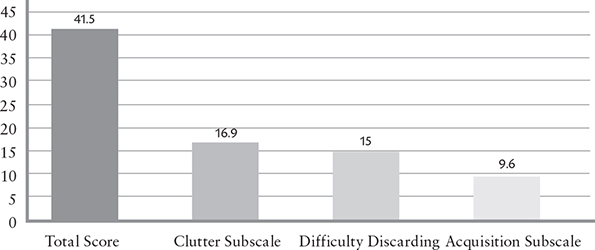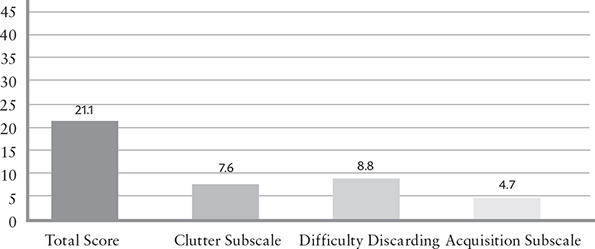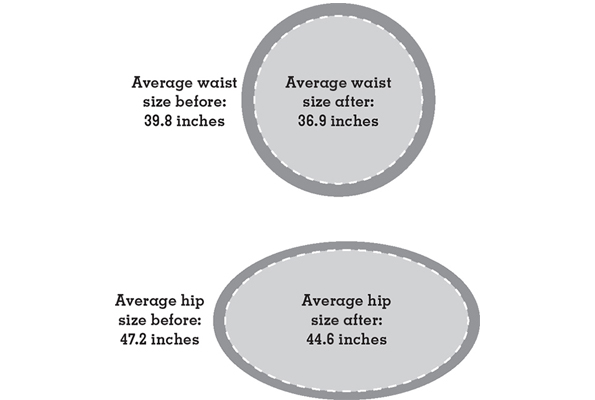Lose the Clutter, Lose the Weight (22 page)
Read Lose the Clutter, Lose the Weight Online
Authors: Peter Walsh
So these weren't folks whose homes and bodies just needed a bit of touching up to get to a level that would make them happy. These were real people with real weight and clutter challenges who were going to have to do some heavy lifting, both mentally and physically.
Once the program began, I stayed in touch with nearly all the participants on a weekly or even daily basis online. I celebrated their joys with them and
listened to the difficulties they were facing. The following comments captured some of the challenges. But keep in mind that all these participants achieved notable successes with their weight, their decluttering, and their attitudes:
Elizabeth:
“I hit an unexpected roadblock with malignant clutter this week in the form of family photos and a filing cabinet of my grandfather's papers. It's malignant nowâI'm still grievingâbut it won't always be. I'm dealing with photos by putting them in archival photo albums and labeling them. They make me sad now but I know they won't always, so I want to have them accessible but not yet displayed. The paper is way harder because it feels a lot like a last connection to someone who has passed, and the way he thought is reflected in them. My plan is to keep a small representative folder, but I've been dragging my feet. I also came off the spool eating-wise and exercise-wise this week, but I'm starting fresh today.”
Linda:
“The weight goes down, then up, then down. I find the temptation to eat wrong is too great when together socially with friends.”
Melissa H.:
“I am running out of motivation to do the decluttering process and am only following parts of the exercise/diet process. I get mad at myself for not following the program and in turn feel bad about myself. It is a daily struggle I dealt with before the program, and here I am again in the same boat. What didn't help was seeing myself in my daughter's prom photos and realizing how much weight I still have to lose.”
Robin:
“I have made some terrific progress in some areasâbut not all four at one timeâand I believe that the changes you make in one area directly can influence the others. But trying to think about and focus on all four at one time (diet, exercise, clutter, and mindfulness) may be a bit much with everything else life has to present to me. That said, I have made progressâI'm not throwing in the towel, but I think that you will need to check back with me at 12 weeks and 18 weeks to get the full picture of how these four activities have been integrated into my daily life.”
Dayl:
“I must admit I am struggling doing all components at once. I work a lot of hours, and when I get home I am exhausted. I have changed my eating habits. No more soda, only diet iced tea or water and of course my one cup of skim milk. Still trying to cut out the sugar (a big, big struggle). I am moving more, taking the time to meditate, and I'm slowly decluttering closet by closet, room by room. Mentally and physically I am feeling much better. I feel the program has definitely helped me, but the realization of doing it all in 6 weeks is not possible for me. Check back in about 15 weeks.”
At the end of 6 weeks, the evidence pointing to their improvements astounded me, to put it mildly. I had a spreadsheet tracking their weight and their attitudes toward clutter, along with their stories and the before-and-after photos of their rooms. These folks made remarkable improvements on all their types of clutter: body fat clutter, stuff-on-their countertops clutter, and mental clutter.
On average, their scores on the clutter questionnaire fell by
nearly half.
Their average total score at the beginning was a hoarding-esque 41.5. Afterward, their average total score was 21.1âwhich is what you might see in the general public. (See the graphs
here
.)
SAVING INVENTORY
BEFORE PROGRAM

SAVING INVENTORY
AFTER PROGRAM

On an individual level, every single person whose original score was at the “hoarding” level was now well below it. Together, they brought out enough unwanted household goods and trash to fill at least one dump truck.
It was just as obvious that the time they spent decluttering didn't stop them from losing weight. On average, they lost nearly 10 pounds apiece. As a group, they lost almost 219 pounds!
Some of the participants pointed out unexpected obstacles that I want to warn you about before you embark on the program. But the general sense I got from them afterward was that the program left them feeling empowered and strong. In just a month and a half, they'd achieved several life-altering victories. They'd lost pounds on the scale, inches from their hips, and piles of trash bags full of clutter from their homes. Here's how you can do it, too.
Your Next 6 Weeks: What to Expect
Every week in the
Lose the Clutter, Lose the Weight
program, you'll be making changes in the following intertwined areas. I'll provide specific advice and activities that take you through them.
A DECLUTTERING PLAN
Each week during the program, you'll tackle a different room or area in your home. You'll be assigned specific “tasks” for each room or space. Some tasks will take only minutes to complete, and some may take days. To help guide you through these tasks, I've provided tips and techniques for tackling each space and dealing with the types of clutter generally found there. I've specifically plotted out your journey so your efforts:
Make a difference early.
You'll start in the rooms that have the biggest impact on your weight and your health.
Start gently.
You won't have to address as many emotionally sticky areas early in the program as you sort through your belongings. The last week will require you to dig deep into the spaces of your home where you have probably
stashed a high density of objects because throwing them away was too painful. By then, you'll hopefully have the mindset to handle getting rid of these items with more confidence and less distress.
Get your body ready for a challenge.
Clearing out your home can be quite a workout. You're lifting, squatting, pulling boxes off high shelves, and perhaps walking up and down stairs. So you'll start the program with rooms that should be less physically demanding. Over the following weeks, you'll have opportunities to grow stronger and more flexible while you improve your endurance. The intent is to get you ready to tackle areas of your home where the items tend to be bigger, heavier, and more unwieldy. You'll likely encounter these items in your final week.
AN EATING PLAN
I wanted the eating plan for the next 6 weeks to be as simple as possible. I don't want to clutter your time or your focus with a lot of dietary rules. I don't want you to count calories or carbohydrates or grams of fat. You have much better things to do with your time. Nor do I want you to have to go to out-of-the-way supermarkets or order foods online. I
certainly
don't want you to have to buy new cooking equipment.
What I
do
want is for you to give your body the right amount of fuel so you stay well-fed and nourished during the coming challenges, but still lose weight. I also want your meals to be pleasurable, so you can sit down and enjoy food that rewards all your senses (it can't be fun to eat mindfully when you have to focus your mind on bland, flavorless food). I also designed this program to be useful and appealing for the long term rather than an ordeal that you can only bear to suffer through for 6 weeks.
In the next chapter, you'll discover dietitian-approved meal and snack plans. All you have to do for the next 6 weeks is pick foods off these charts. So long as you choose a breakfast, lunch, dinner, and any snacks from these lists, you'll stay within a daily calorie range that encourages weight loss.
A FUNCTIONAL FITNESS PLAN
You'll burn off calories every day while decluttering your house. It's quite possible that this amount of physical activity alone would be enough to spark your weight loss. But you'll set yourself up for even better results if you do additional physical activities several times a week. I worked with an exercise
physiologist, Liz Davis, MS, to develop a special workout plan to go with this program.

The test panelists were able to make big changes in their appearance in a hurry. On average, they lost nearly 3 inches from their waists and about 2½ inches from their hips. Their energy level went up, and so did their self-esteem.
I'll let them tell you how they felt after 6 weeks.
Elizabeth:
“This has been the best thing I have done for myself in a really long time.”
Nanette:
I've continued to exercise, and I've made some really smart choices in relation to food. I am so thankful that I was able to be a part of this test panel. I have struggled with weight issues for many years, and it wasn't until I made this commitment that I have seen significant results. Although I have more work ahead, I vow to practice your principles.”
Melissa H.:
“Was I perfect all the time? Um, no. But, if I can survive the Easter holiday and still come away with losing weight, then I think I had success. As for all the ladies (and Joe too!), I heard different variations of success as we gathered together yesterday. We all made improvements in our health and our homes. As for the decluttering, I was not able to declutter my entire house in 6 weeks, but just getting started has motivated me to keep going.”
Along with changing your appearance, we wanted the exercises in this program to help your body work more effectively. A current focus in the field of exercise science is on functional fitness. This approach isn't so much concerned with your looks. Instead, the goal is to ensure that you can squat down and pick up a box from the floor, then place it on a shelf. You can spend an active day of grocery shopping, gardening, and playing with your kids or grandkids and not feel exhausted that night and sore the next day. Your muscles and joints stay strong and limber, and your heart and lungs don't become strained during normal use. In short, your body
functions
better.
The idea here isn't to build big muscles or a tiny waist just for appearance's sake, which you then have to maintain with time-consuming workouts. Instead, the
Lose the Clutter, Lose the Weight
fitness plan aims to make your overall life healthier, happier, and easier.
It's also cheaper than many exercise plans. You'll notice in
Chapter 7
, which provides the directions for each exercise, that none of these activities requires you to buy any weights or other equipment. You could fill a large gym with all the unused workout equipment I've seen in people's homes. So I was determined that this program would provide all the exercise you need without sending you to the store for a single new piece of workout gear.
You'll start with short walks during the first week and gradually go farther, until you're walking for 30 minutes at a time in the final week. You'll also regularly do strength- and flexibility-building movements using household objects or your own body weight. As you fill bags with castoffs that will go to the donation center, you'll use them to strengthen your legs, back, arms, and shoulders. As you clear countertops and walls, you'll use this reclaimed space for doing pushups!